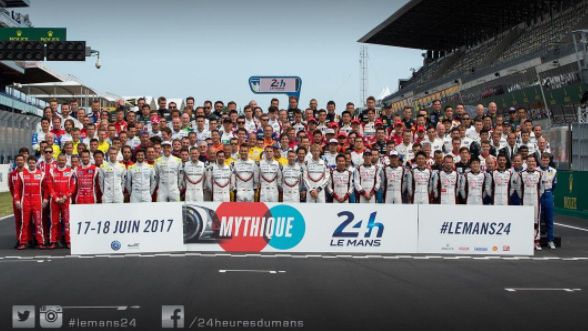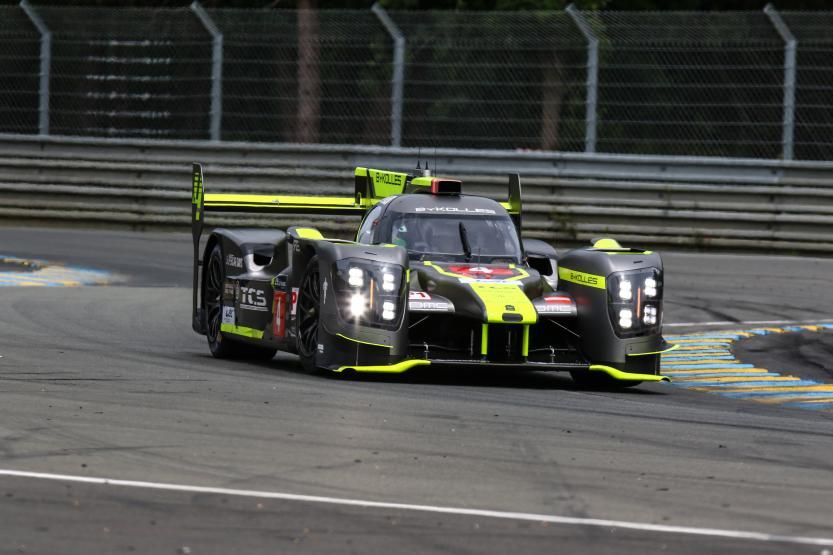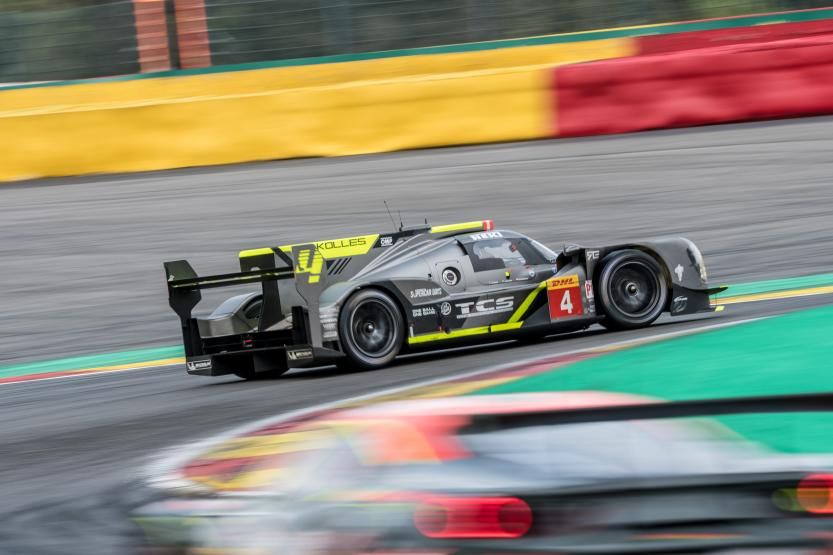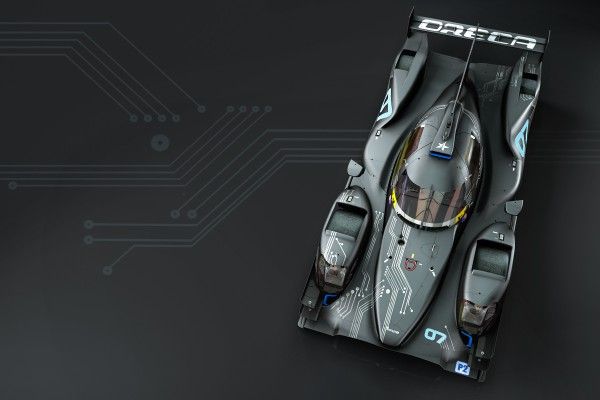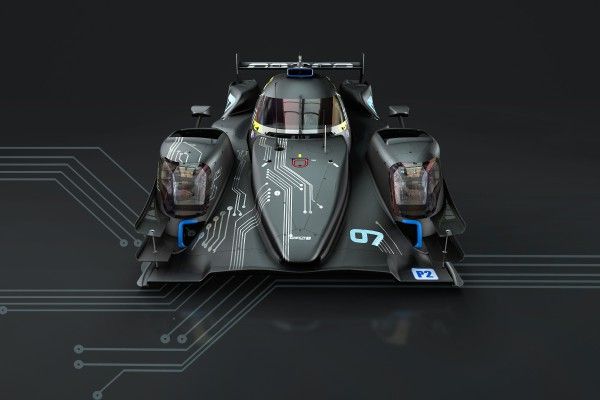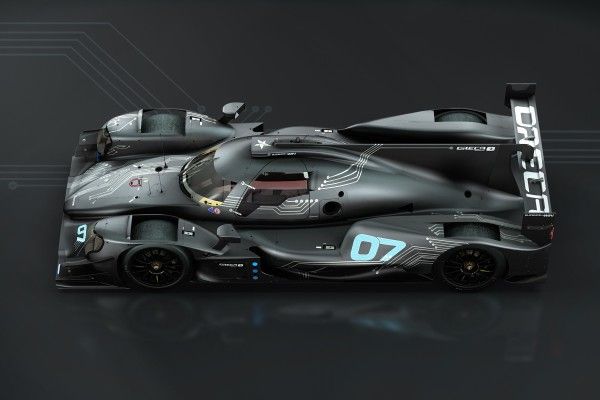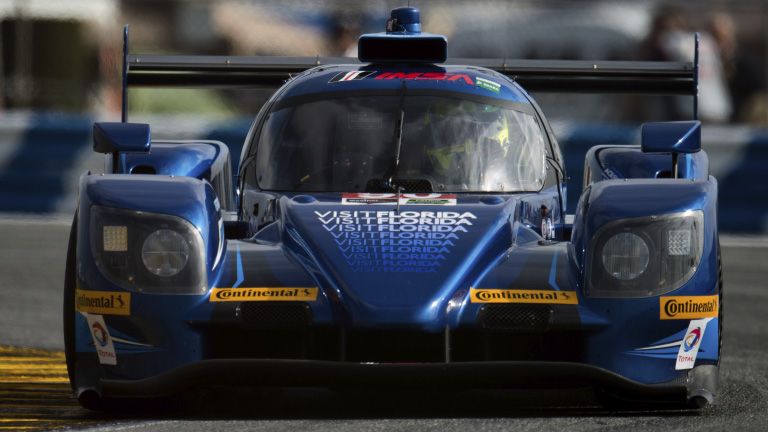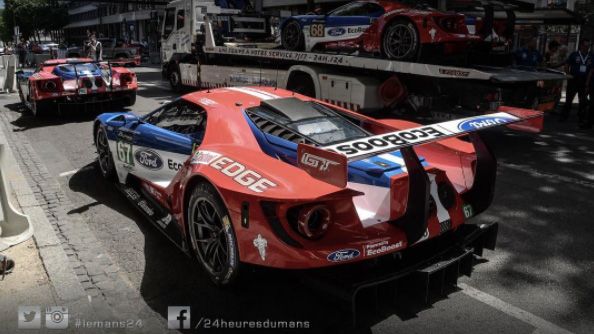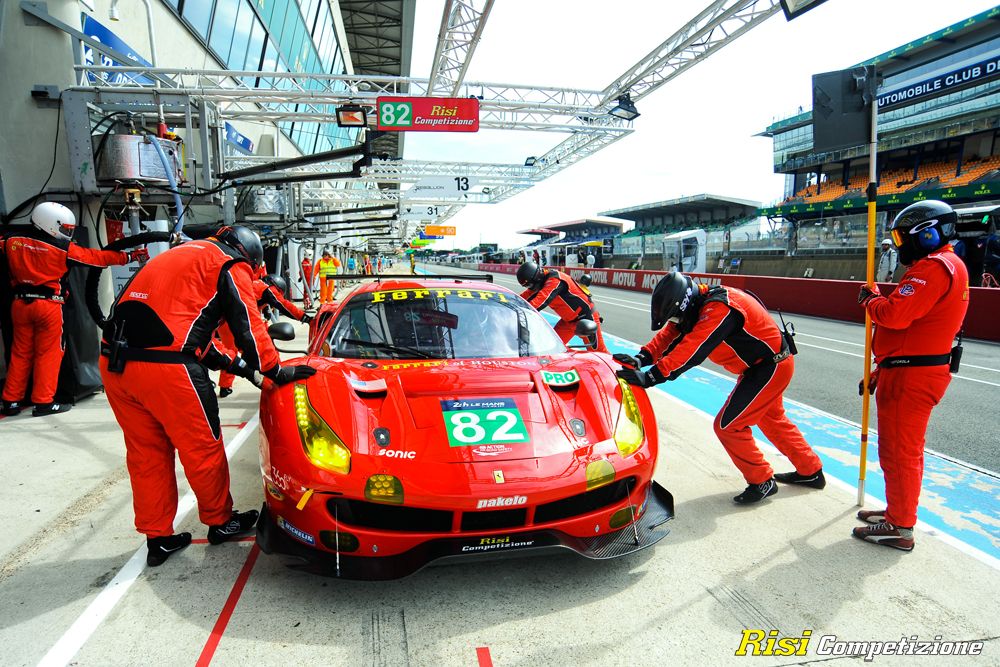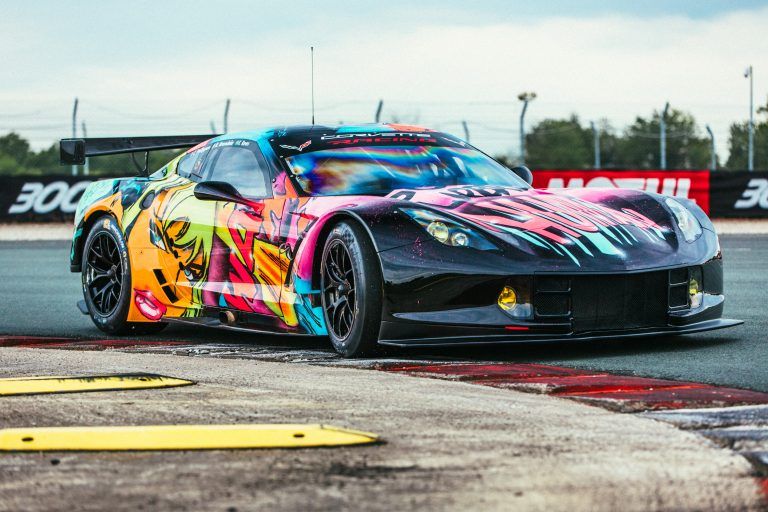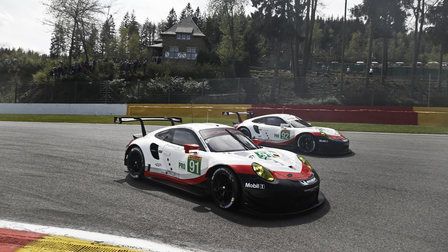For the 85th time in history, the crème de la crème in the world of endurance racing gathers in the La Sarthe valley in France for what they call "Les 24 Heures Du Mans". This time around, it’s all about the Porsche vs. Toyota duel for the overall win while Ford seems to have a much harder job ahead if they want to go back to back in GTE-Pro. This year we’ve got again four classes and a 60-strong field with the biggest being LMP2, boasting a 25-car grid. There are only six LMP1 cars, five of which are the works hybrid machines, only one being a non-hybrid "light" prototype. GT cars make up the rest of the 29 vehicles, divided between GTE-Pro and GTE-Am. The former is made up of 13 cars, the remaining racers being entered in GTE-Am which also allows older spec GTE machinery.
The talk of the town is, obviously, the fight between Toyota and Porsche, especially after last year’s heart wrenching story that saw Toyota Gazoo Racing’s Kazuki Nakajima stop on the start/finish straight as there was just one more lap left to go of the 24-hour-long race. The electrical gremlin meant that Porsche scored an unexpected 18th overall win and the second in succession after their 2015 triumph. Toyota is back 12 months later and, this time, it’s all guns ablaze: three cars, nine drivers and a dramatically improved package. Porsche, the defending world champions as well, come with two cars, the German brand still feeling the reverb of the Dieselgate scandal.
Continue reading for the full story.
LMP1
The introduction of hybrid technology all the way back in 2012 dramatically shrunk the number of cars in the top class of the Le Mans race and ruled out this category from the continental series. From multiple chassis providers and up to 20 cars in 2008, only a dozen were left in 2012 when Audi first answered the call and pitted the R18 Hybrid E-Tron Quattro. By then, Peugeot had left but soon Toyota joined and then Porsche. It looked even better in 2015 when there were also three brand-new, innovative, Nissans on the grid and, to compound it all, three non-hybrid cars. It made for an astounding 13-car grid but it didn’t last. Now, only two years down the line, Audi’s out, as are Nissan and LMP-L (for Light) contenders Rebellion. The doomsday predictors already talk of an end of the hybrid era but it’s hard to outline what’s coming up next.
|
Porsche 919 Hybrid |
Toyota TS050 Hybrid |
What we know for a fact today is that we’ve had a storming debut to the 2017 WEC. Porsche went head to head with Toyota first at Silverstone which asks for a high downforce package. Toyota came with this pack but Porsche decided, instead, to fit their cars with the low-downforce aero bits. It’s all down to the rules which, now, limit the manufacturers to only two aero kits per season and a limited number of wind tunnel hours to develop the said packages. It’s also notable the fact that you can’t really update the packages after you’ve launched them. That’s why Porsche decided to debut their low-downforce package, thus opting to “bake” their high downforce setup for a while longer, until the Nurburgring round. This will aid Porsche since the bulk of the rounds after Le Mans, minus Fuji, require more drag. Toyota did the opposite, deciding to postpone the launch of their low-drag package in a bid to refine it for their ultimate goal: winning Le Mans outright.
|
Porsche 919 Hybrid |
Toyota TS050 Hybrid |
In a weird turn of events, Toyota’s high downforce package found it hard to fend off the low-downforce Porsche at Silverstone and then, at Spa, Porsche kept up with the same high-drag Toyotas much harder despite having the (theoretically) more fit package. On top of that, the third TS050, which debuted the low-drag aero, was the slowest of the three Japanese prototypes in the Ardennes. Still, Toyota comes to La Sarthe with two wins to Porsche’s zero but Le Mans is a double point scoring round so it could be all back to level playing field after June 17-18.
First off, the title defenders. They bring the No. 1 and No. 2 919 Hybrids with some heavily revised front ends but a less aggressive low-drag setup, especially in the sidepod area. The Porsche team also seemingly have opted to not go for ultimate speed with their new car, admitting early that they can’t contest with Toyota in the qualifying department. This was a department in which Toyota was particularly lacking so the Japanese, alongside with the Cologne-based TMG team, have come up with a car that is blindingly fast over one lap, probably due to a very aggressive engine mapping as well.
|
Prosche 919 Hybrid |
Porsche’s No. 1 car features only Neel Jani from the lineup that won the race last year. Both Romain Dumas and Marc Lieb have been sidelined, the former still competing but in LMP2, while the latter has been given a desk job at Porsche to keep him busy. In their place we find Andre Lotterer, Audi’s quickest pair of hands, and 2015 Le Mans winner Nick Tandy who’s a master of wet weather driving and, barring some mistakes he’s done in the past, is as fast as the other guys on almost any day. The No. 2 has only one new driver after the retirement, at the end of 2016, of Mark Webber. That’s Earl Bamber who will join Brendon Hartley and Timo Bernhard. The German is the most experienced of the bunch and is still as consistent as ever. Bamber has already proved his prowess in a P1-H car, as did Hartley.
So the driver quality isn’t an issue for Porsche. The issue is the pace. The No. 2 car suffered from an almighty oil leak during the official Test Day which required an engine swap. That meant the car only completed 40-odd laps, the best one in the 3:21s. The other Porsche was even slower, posting a fastest lap time in the low 3:22s. That’s some three seconds off Toyota’s quickest lap time. Can Porsche make up this gap and, more importantly, are the two cars more evenly matched in race pace? We’ve got to wait until Saturday for the answers.
|
Toyota TS050 Hybrid |
It’s clear, now, that Toyota Gazoo Racing has the speed. They also had a faultless Test Day and have two wins in the bag out of two possible. The numbers are also on their side, bringing three TS050s to Porsche’s two 919s. But their lack of luck at La Sarthe is almost proverbial so the Japanese are still keeping their wits about them. The new car is a true leap ahead in performance with an ingenious low-downforce package that raised the eyebrows of Porsche so much at Spa that the Germans filed a complaint saying that the rear bodywork is not compliant with the rules. The ACO found no problems with it so it was on with the show but Toyota seems to finally be with one step properly ahead.
Their driver roster seems to be very capable of making the best out of that advantage. The No. 7 lineup is made up of Kamui Kobayashi, Mike Conway and Stephane Sarrazin. The Frenchman will swap seats with Jose-Maria Lopez after the Argentine’s crash in the opening round of the championship. The WTCC champion will thus drive in the No. 9 car. The No. 8 features the unchanged lineup of Anthony Davidson, Kazuki Nakajima and Sebastien Buemi who are probably as strong as the sister No. 7 crew. The No. 9 lineup is completed by Nicolas Lapierre, returning to LMP1-H after two very successful years in LMP2, and Super GT and Super Formula stalwart Yuji Kunimoto. This puts the third Toyota at a bit of a disadvantage since two of the three drivers are Le Mans rookies but if they keep out of trouble, they could be of very much aid to their team-mates or even produce an upset!
|
ByKolles’ ENSO CLM P1/01 |
ByKolles’ ENSO CLM P1/01 is the only remaining non-hybrid P1 car. It has now a new motor in the middle, the 2015 Nissan twin-turbo powerplant which seems to be, strangely, more reliable than the AER unit used last year. With the Nissan engine they finished sixth at Spa, also beating all of the new (and much quicker) P2 cars in the process. Audi man Marco Bonanomi will join Oliver-James Webb and ex-Rebellion driver Dominik Kraihamer in this Austrian effort that will, probably, withdraw from the WEC after the German round.
|
ByKolles’ ENSO CLM P1/01 |
The reason behind Colin Kolles reported decision is the big news in LMP1: no less than three manufacturers will likely join the series in the P1-L sub-class come 2018. They are Perrinn, Dallara and Ginetta which could boost the grid size of the category to six or even more. This prompted Kolles to decide to cut the season short to concentrate his manpower and cash on redesigning their contender to take on the new rivals next season. It’s a wise decision since they are basically running on their own race in and race out. What’s important for their future success is an untroubled run at Le Mans to gather more data but this might be tricky if we look at their record of DNFs.
LMP2
The secondary prototype division has gone through a makeover between 2016 and 2017. The former cost-capped class is now a semi-spec one where one engine manufacturer, Gibson, delivers all the motors and teams get to choose between only four chassis builders: Dallara, ORECA, Ligier and Riley/Multimatic. All of them will be represented at the big race but, looking at what we’ve had in the Test Day, it might be a one horse race. Or, rather, a one breed-of-horse race.
That’s because the new ORECA 07 P2s have proved much quicker over a lap than their rivals. The 14 cars built by Hughues de Chaunac’s company were some five to ten seconds quicker a lap than everyone else which has raised many complaints in the field. Jacques Nicolet, the man behind OnRoak Automotive which build the Ligiers, even went as far as asking Vincent Beaumesnil for a waiver to be able to come to the race proper with an updated low-drag setup for their cars which lose out both on the straights and in the corners.
The rules s they are now state that the P2 2017-spec cars get one major update in their four-year lifespan and no other update in this time. This meant that Nicolet had to come to terms with the fact that his teams will have to run with what they’ve brought. Which are a bunch (seven, to be precise) of second-class citizens since the first 13 spots in P2 at the Test were filled by ORECAs (13 out of 14, to put it in perspective once more).
The Dallars, of which there are three, have less of a problem in the straights, the Cetillar Villorba Corse example setting the quickest top speed of all in the test. In fact, the P2s were way quicker than all of the prototypes. Villorba’s car ran at a staggering 211 mph on the Mulsanne Straight which is in excess of 210 mph. That’s some 8 mph quicker than the hybrids and 4-5 quicker than the sole ByKolles. The Dallara has, however, proved rather unreliable and with one of the entrants not running any races with the car this year (SMP Racing), the Italian manufacturer’s chances are even smaller than those of Ligier (Zak Brown’s United Autosports also runs a Ligier while Dragonspeed runs two ORECAs, one under its own name and another jointly with G-Drive Racing).
|
Riley/Multimatic Mk.30 |
Finally, we have the only American car, the Riley/Multimatic Mk.30. Only one such car will be on the grid entered by Ben Keating’s Keating Motorsport/Riley Technologies outfit. The driver pairing is strong with Ricky Taylor and Jeroen Bleekemolen featuring alongside Keating but the car was 10 seconds slower than the ORECAs and has now racing miles under its belt being only the second chassis built. Keating hopes to be able to run Le Mans with it in the next three years of its life but that depends on the way it will run this time around as ACO doesn’t have the habit of inviting to its crown jewel the slowest of competitors, as much as they might be crowd pleasers.
GTE-Pro
2016 was a very awkward affair in GTE-Pro. Ford basically sandbagged their way into a good Balance of Performance and everyone else, barring from Ferrari, were left baffled in their dust. Granted, everyone in motorsport sandbags now and again but it’s rare to see a sanctioning body giving such a performance waiver to a competitor after such a scheme. To put it in perspective, now, with what Chip Ganassi Racing calls "an uncompetitive BoP", the GTs are a whole seven seconds (7!) slower than they were last year which was, mind you, their first in GTE competition. Still, there will again be four of these amazing machines, two from the U.K. (WEC-bound) arm and two from the U.S. (IMSA-bound) arm.
Joey Hand and Dirk Muller will again partner in the car that won last year but they won’t have the help of Sebastien Bourdais after his monster crash during the Indy 500 weekend. Instead, another Indycar star will sub for the Frenchman. The man in question is none other than the 2016 winner of the Daytona 24hrs with Ford, Tony Kanaan. He is, however, a Le Mans rookie but is no slouch in endurance so he should do more than `just fine`. The other three Fords have lineups which are just as good and they better have given the increased challenge from Corvette, Porsche, Ferrari and Aston-Martin.
Corvette Racing were the quickest in the test thanks to Oliver Gavin’s brilliant lap ahead the No. 64. In hindsight, it might not’ve been the best of decisions for the Briton as his team was slapped with a more disadvantageous BoP for the race following their performance, having a smaller air restrictor opening that will take away some 10 hp from the already strangled powerplant. Still, Corvette Racing are known for their strategic prowess and lightning-quick pitwork so they should be able to work around the performance drawback.
Porsche were second- and third-quickest and have put behind the fire at Silverstone that put one of their new middle-engined cars out of the race. The change from putting the engine behind the rear axle to placing it in front of the axle has been visible with the car much more handy through the fast corners of Circuit de la Sarthe. Richard Lietz, Patrick Pilet and Fred Makowiecki partner in what should be the strongest lineup which has No. 91 on the doors and hood.
There will also be three Ferraris. The No. 82 Risi car returns after being the only one to fight the Fords last year (and finishing third). Pierre Kaffer will join Giancarlo Fisichella and Toni Vilander in Giuseppe Risi’s car which has had all the bad luck in the world in the first few IMSA races this season. The American team knows how to win Le Mans having won it in the F430 GT2 days and hope to turn their luck around at this most iconic of events. AF Corse hope to do just the same after a miserable 2016 race from which they were out quite quick. Now, the no. 51 and no. 71 are more reliable and come off the heels of a 1-2 victory at Spa. Alessandro Pier Guidi is Gianmaria Bruni’s replacement and the Italian, despite being a Le Mans rookie, is one of the quickest in the business and surely will be able to fill Bruni’s big shoes. James Calado is also in the lineup alongside Lucas Di Grassi who will make only his second start ever in a GT car after a career spent with Audi and in open-wheelers. Davide Rigon, Sam Bird and Miguel Molina, another Audi driver, will drive the No. 71.
Finally, Aston Martin Racing pit their venerable Vantage one more time against the world. The car, which has a base that dates back to 2008, took the title with the No. 95 crew last year after a controversial BoP change. 2017 hasn’t been nearly as kind for the Prodrive-built cars and Aston hope to turn their fortunes around after missing the GTE-Pro victory time and again since 2012. Their last win in the top GT category dates back to 2008 when the top GT tier was GT1! They have now Dunlop rubber and Dunlop’s test driver, Daniel Serra, to try to do the near impossible and win.
GTE-Am
Multiple cars from multiple backgrounds add color and variety to the GTE-Am category. Only five of the 16 actually do the full WEC season and one of these is, arguably, the class favorite: the No. 98 works Aston-Martin. This car, which was also quickest at the test, has though missed out on a Le Mans win in the past two years which also deprived Mathias Lauda, Paul Dalla Lana and Pedro Lamy of the class title. They’re confident all the bad luck is behind them and they can win in the Vantage that has no secrets for the trio.
There will also be two other Astons from TF Sport and Beechdean AMR as well as four Porsches and a pack of Ferraris but the fan favorite is none of these. Instead, it’s the Larbre Corvette C7.R which retunrs without doing the full WEC season. To make up for that, Jack Leconte’s team have unveiled a stunning Art Car for next-weekend’s challenge which features day-glo paint. To double the beauty on the outside, the car is also fast, Larbre returnee Fernando Rees going second quickest at the test. However, his two team-mates, Romain Brandela and Christian Philippon are much slower being both Bronze-rated drivers (Gentleman Drivers).
Continuing with the American theme, Scuderia Corsa, last year’s winners, return with two 488 GTEs. No. 62 features backing from David MacNeil’s Weathertech company and his son, Cooper, in the driver roaster. Alongside the IMSA regular we find last year’s winners Bill Sweedler and Townsend Bell who will once more target the top step of the podium. They will, most likely, clash with their team mates in the No. 65. They are Alessandro Balzan, Christina Nielsen (reigning GTD champions in IMSA) and Bret Curtis.
|
Prosche 991 GTE |
The Dempsey-Proton Porsche returns once more, still without Patrick in the lineup. Matteo Carioli and Marvin Dienst, two of Porsche’s quickest youngsters, will drive the 2015-spec 991 GTE alongside Christian Ried. Their problem will be that the ACO has had a troublesome time trying to balance the older Porsches to the newer 488 GTEs, the Corvette and Astons.
Other notable entries are the No. 84 JMW Ferrari which is, for the first time ever, not a 458. The British squad will debut their new 488 at Le Mans after winning with their old (six years old!) car at its last outing in the ELMS at Monza. They have the driving talent in Rob Smith, Will Stevens and Dries Vanthoor but they (the drivers) lack the experience as does the team with their new car. The Krohn colors are also set for a return after Tracy Krohn’s Krohn Aviation company will cover the DH Racing Ferrari. Krohn will drive the car alongside long-time team mate Nic Jonsson and FIA GT champion Andrea Bertolini who needs no further introduction given his feats in the Vitaphone Maserati MC12 in the late 1990s.
All in all, the GTE classes are close this year, definitely the Pro division much closer than in 2016, so it’s hard to pinpoint a winner. It will be a tough race even though rain doesn’t seem to be on the cards.
The Race
The 85th running of the 24 Hours of Le Mans kicks off on June 14 with four hours of official practice. This will be followed by two qualifying sessions, each two hours long, on June 14 and 15. The race will be begin at 3:00 PM local time (9:00 AM EST) on June 17 and end exactly 24 hours later in June 18.

